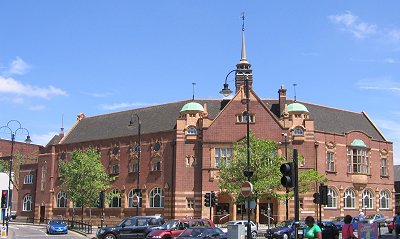|

Listing: 1900-1902. By H. T. Hare. Free Renaissance style. A particularly
good example of this style.
Literature: Richard Fellows, Edwardian
Architecture: Style and Technology, Lund Humphries, 1995, pp. 128 - 134. A
detailed analysis of the building and its historical context.
The Architectural Review, March 1906, Vol.XIX, No.112,
pp. 129-134.
The historical background to Wolverhampton public libraries can
be found in: Joseph Jones, Historical Sketch of the Art and Literary
Institutions of Wolverhampton, Alexander and Shepherd (London), 1897.
Comment: The listing says this is a good example of this
style. Readers are invited to give other examples of this architectural
style. Maybe its very individuality makes it such a well known contribution to
Wolverhampton's townscape. It certainly adds interest to what is now otherwise a
rather bleak junction.
The building seems to have been designed down to a cost
but Hare did very well indeed within his financial limitations. The
interior also has some nice features, including a good staircase and a
balconied reading room. (Photos of the interior at the building's
opening are to be found in the Architectural Review article cited
above.)
The Architectural Review gives details of those
concerned with the building: "The general contractors were Messrs.
Willcock & Co., of Wolverhampton. Mr. W. Aumonier, of London,
executed the carving; Messrs Doulton, London, supplied the terra
cotta; Messrs. W. H. Lindsay & Co, London, executed the
ferro-concrete, steel work and fire resisting construction; Messrs
Hope & Sons, Birmingham, supplied the casements and fittings; and
Messrs. Starkie Gardner & Co., London, the gates, railings, etc.
The Gahtryx [sic] Engineering Co. carried out the heating and
ventilating; and the District Electric Co., Wolverhampton, executed the
electrical wiring. The general furnishing is by Messrs.
Hewetson, London. Mr. Henry T. Hare, of 13 Hart Street,
Bloomsbury, is the architect." The lack of Wolverhampton names
amongst the suppliers is notable.
The plaques above the first floor windows carry the names of the
usual literary luminaries beloved of the Victorian age. Above the entrance is
the royal coat of arms and an inscription: "Built to commemorate the sixtieth
year of Queen Victoria's reign". That may be a case of being loyal after the
event.
This building has accommodated the library since its opening and
continues to do so, rather successfully, despite being too small; and it is too
small despite several attempts at improving matters within the existing building
- and removing the archives across the road. There is now a £2 million
project in the pipeline to upgrade the whole set up and plans for the upgrading
of the whole Old Hall Street site which includes this building. Part of
the scheme is for a large extension at the back of this building, which will not
affect its frontage but which will considerably improve the rather dull and
altered back.

|